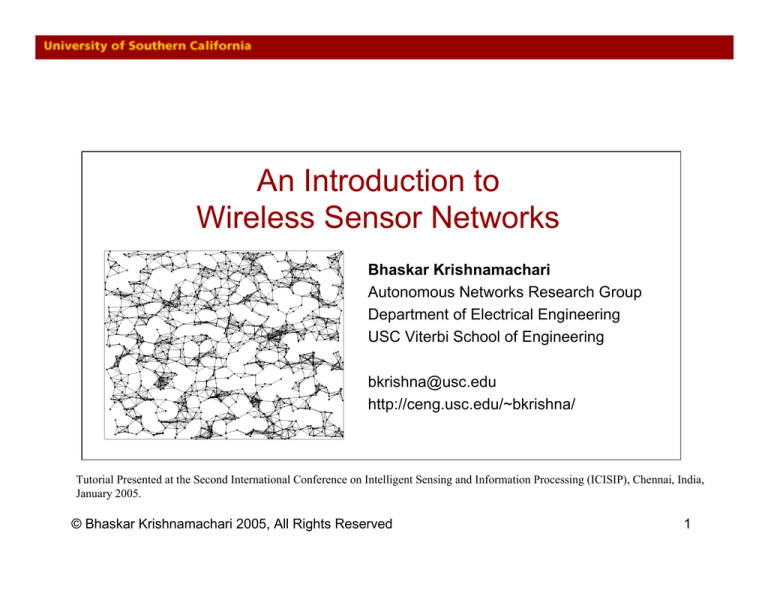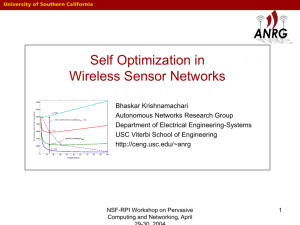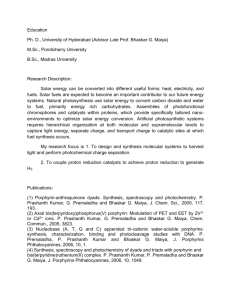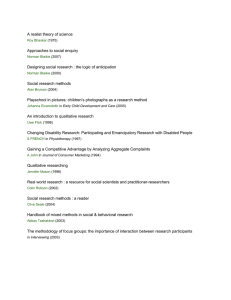An Introduction to Wireless Sensor Networks
advertisement

An Introduction to Wireless Sensor Networks Bhaskar Krishnamachari Autonomous Networks Research Group Department of Electrical Engineering USC Viterbi School of Engineering bkrishna@usc.edu http://ceng.usc.edu/~bkrishna/ Tutorial Presented at the Second International Conference on Intelligent Sensing and Information Processing (ICISIP), Chennai, India, January 2005. © Bhaskar Krishnamachari 2005, All Rights Reserved 1 Overview © Bhaskar Krishnamachari 2005 2 Wireless Sensor Networks (WSN) • The “many - tiny” principle: wireless networks of thousands of inexpensive miniature devices capable of computation, communication and sensing • Their use throughout society “could well dwarf previous milestones in the information revolution”: U.S. National Research Council Report, 2001. Berkeley Mote (MICAz MPR 2400 Series) © Bhaskar Krishnamachari 2005 3 Timeline • • • • • • • 1970’s: Wired sensors connected to central location 1980’s: Distributed wired sensor networks 1993: LWIM project at UCLA 1999-2003: DARPA SensIT project: UC Berkeley, USC, Cornell etc. 2001: Intel Research Lab at Berkeley focused on WSN 2002: NSF Center for Embedded Networked Sensing 2001-2002: Emergence of sensor networks industry; startup companies including Sensoria, Crossbow, Ember Corp, SensiCast plus established ones: Intel, Bosch, Motorola, General Electric, Samsung. • 2003-2004: IEEE 802.15.4 standard, Zigbee Alliance. © Bhaskar Krishnamachari 2005 4 Wireless Sensor Networks (WSN) • Provide a bridge between the real physical and virtual worlds • Allow the ability to observe the previously unobservable at a fine resolution over large spatio-temporal scales • Have a wide range of potential applications to industry, science, transportation, civil infrastructure, and security. © Bhaskar Krishnamachari 2005 5 Some Sample Applications • • • • • • • • Habitat and Ecosystem Monitoring Seismic Monitoring Civil Structural Health Monitoring Monitoring Groundwater Contamination Rapid Emergency Response Industrial Process Monitoring Perimeter Security and Surveillance Automated Building Climate Control © Bhaskar Krishnamachari 2005 6 Basic Components of a WSN Node © Bhaskar Krishnamachari 2005 7 Challenges • Energy Efficiency • Responsiveness • Robustness • Self-Configuration and Adaptation © Bhaskar Krishnamachari 2005 8 Challenges (contd.) • Scalability • Heterogeneity • Systematic Design • Privacy and Security © Bhaskar Krishnamachari 2005 9 Outline for the Rest of the Tutorial • • • • • • • • • Deployment Localization Time Synchronization Wireless Link Characteristics Medium Access Sleep Based Topology Control Routing Data Centric Networking Transport © Bhaskar Krishnamachari 2005 10 Deployment © Bhaskar Krishnamachari 2005 11 Deployment Issues • Structured versus Randomized Deployment • Overdeployed versus Incremental Deployment • Connectivity and Coverage Metrics of Interest © Bhaskar Krishnamachari 2005 12 Network Topologies © Bhaskar Krishnamachari 2005 13 Random Graph Models • For some applications, WSN nodes could be scattered randomly (e.g. from an airplane) • Random Graph Theory is useful in analyzing such deployments • The most common random graph model is G(n,R): deploy n nodes randomly with a uniform distribution in a unit area, placing an edge between any two that are within Euclidean range R. © Bhaskar Krishnamachari 2005 14 Geometric Random Graph G(n,R) sparse © Bhaskar Krishnamachari 2005 dense 15 Some Key Results • All monotone graph properties have an asymptotic critical range R beyond which they are guaranteed with high probability (Goel, Rai, and Krishnamachari ‘04) • The critical range for connectivity is (Penrose ‘97, Gupta and Kumar ‘98) • The critical range to ensure that all nodes have at least k neighbors also ensures k-connectivity w.h.p. (Penrose ‘99) © Bhaskar Krishnamachari 2005 16 Connectivity in G(n,R) © Bhaskar Krishnamachari 2005 17 Power Control • Provides a degree of flexibility in configuring the network connectivity after deployment. • Must carefully balance several factors, including connectivity, energy usage, and interference. • The CBTC (Li et al. ‘01) provides a distributed rule for global connectivity: increase power until there is a neighbor within range in every sector of angle α≤5π/6 © Bhaskar Krishnamachari 2005 18 Coverage Metrics • Much more application specific than connectivity. • Some that have been studied in particular detail are: – Path observation metrics: An example of this is the maximal breach distance, defined as the closest any evasive target must get to a sensor in the field (Meguerdichian et al. ‘99) – K-Coverage: ensure that all parts of the field are within sensing range of K sensors (e.g. Wang et al. ‘03) © Bhaskar Krishnamachari 2005 19 Key Results on K-Coverage • A field is K-covered if and only if all intersection points between sensing circles are at or inside the boundary of K+1 sensing circles. (Wang et al. ‘03) • If a region is K-covered by n sensors, they also form a Kconnected graph if their communication range is at least twice the communication range. (Wang et al. ‘03) © Bhaskar Krishnamachari 2005 A 2-covered region 20 Localization © Bhaskar Krishnamachari 2005 21 Localization Issues • Location information necessary/useful for many functions, including measurement stamps, coherent signal processing, cluster formation, efficient querying and routing. • Key Questions: – – – – What to localize? When to localize? How well to localize? How to localize? © Bhaskar Krishnamachari 2005 22 Coarse Grained Node Localization Several techniques provide approximate solutions for node localization based on the use of minimal information: • • • • • Proximity Centroids Geometric Constraints APIT Identifying Codes © Bhaskar Krishnamachari 2005 23 Geometric Constraints Reference node Unknown node Constrained location region Disc Quadrant © Bhaskar Krishnamachari 2005 Sector Annulus (Doherty, Pister and Ghaoui ‘01) 24 Approximate Point in Triangle (APIT) (He, Huang, et al. ‘03) © Bhaskar Krishnamachari 2005 25 ID-Codes (Ray et al. ‘03) © Bhaskar Krishnamachari 2005 26 Fine-Grained Node Localization • Basic Approach: Ranging – ranging using radio signal strengths (m-level accuracy) – ranging using time difference of arrival (cm-level accuracy over short distances) • Position estimation is then an MMSE problem: Ej = Ri,j - √ ((xi-xj)2+(yi-yj)2) Find (xi,yi) to minimize Σ (Ej)2 • Angle of arrival techniques are particularly useful in conjunction with ranging © Bhaskar Krishnamachari 2005 27 Time Difference of Arrival Transmitter To Acoustic RF Receiver Tr Ts Distance ≅ (Tr – Ts) . Vs © Bhaskar Krishnamachari 2005 28 Fine-Grained Node Localization (contd.) • Pattern matching techniques such as RADAR (Bahl and Padmanabhan, ‘00) require pre-training of signal strengths at different locations in the environment. • Ecolocation (Yedavalli et al. ‘04) is based on sequence decoding. – Record the received signal strengths at different reference nodes from a given unknown node, and order these into a sequence – Return as the unknown node’s location the location that “best matches” the measured sequence © Bhaskar Krishnamachari 2005 29 Network Localization • Different from node localization. Few reference nodes and several networked unknown nodes. • Several approaches: – Constraint satisfaction/optimization (centralized) – Joint estimation using ranging estimates (centralized) – Multihop distance estimation (distributed) – Iterative localization (distributed) – Potential fields (distributed) © Bhaskar Krishnamachari 2005 30 Iterative Localization (0,10) C G D F E L (10,10) (5,5) J I K A (0,0) © Bhaskar Krishnamachari 2005 H B (10,0) 31 Iterative Localization 1. (5, 25/3) (0,10) C 3 G 2 (5,5) E (10,10) D F J L 6 I 7 K 4 A (0,0) © Bhaskar Krishnamachari 2005 H 5 B (10,0) 32 Reference-less Localization • What if there are no reference nodes with known locations? • Three-step solution (Rao ‘03): – 1. If all boundary nodes have known locations, use iterative centroid calculations – 2. If boundary nodes do not have known locations, use pairwise hop-counts to get approximate locations and apply step 1. – 3. If nodes are not aware of boundary, use a flood to identify boundary nodes and apply step 2. • The solution provides only a relative map, useful for geographic routing © Bhaskar Krishnamachari 2005 33 Illustration of Reference-less Localization Correct locations © Bhaskar Krishnamachari 2005 Localization assuming only known boundary nodes 34 Rigidity and Unique Localization • The network is said to be uniquely localizable if there exists a unique assignment of (x,y) coordinates to all nodes that is consistent with the available positions and distance estimates in a network. • Let GN be the grounded graph, i.e. the network graph augmented with distance-labelled edges between all pairs of reference nodes. • Theorem: A network is uniquely localizable if its grounded graph is globally rigid. (Eren et al. ‘04) © Bhaskar Krishnamachari 2005 35 Global Rigidity A Not Rigid E E B B A D D C (a) C (b) Rigid A E B E B A D C (c) © Bhaskar Krishnamachari 2005 D C (d) 36 Time Synchronization © Bhaskar Krishnamachari 2005 37 Synchronization Techniques • Receiver Broadcast Synchronization: multiple receivers synchronize to the same broadcast (Elson, Girod, and Estrin ‘02) • Timing-Sync Protocol for Sensor Nets (TPSN): traditional sender-receiver synchronization (Ganeriwal, Kumar and Srivastava ‘03) • FTSP: Multiple time stamping at sender and receiver for each packet to mitigate processing time jitter. Possible to synchronize nodes to within 1µs. (Maroti et al. ‘04) © Bhaskar Krishnamachari 2005 38 Reference Broadcast Synchronization © Bhaskar Krishnamachari 2005 39 TPSN © Bhaskar Krishnamachari 2005 40 Wireless Link Characteristics © Bhaskar Krishnamachari 2005 41 Empirical Observations • Early studies all assumed a simple perfect-connectivitywithin-range model for simulations and analysis. • A number of empirical studies suggest this can be very misleading ( Ganesan ‘02; Zhao and Govindan ‘03; Woo, Tong and Culler ‘03). • A better characterization is that links fall into three regions: connected, transitional and unconnected. The transitional region will contain a large number of unreliable links. © Bhaskar Krishnamachari 2005 42 Link Regions © Bhaskar Krishnamachari 2005 43 Received Signal Strength © Bhaskar Krishnamachari 2005 44 Radio Reception © Bhaskar Krishnamachari 2005 45 Explanation for Link Regions (Zuniga and Krishnamachari ‘04) © Bhaskar Krishnamachari 2005 46 Link Quality Assurance • Blacklisting: Identify neighbors with poor link quality (weak/highly variable/asymmetric links) and eliminate them from neighbor table (Woo, Tong and Culler ‘03, Gnawali et al. ‘04). • Blacklisting can be implemented using a global threshold or using a local rule like blacklisting all but the top k links. • Blacklisting provides reliable link quality at the risk of providing a disconnected topology. © Bhaskar Krishnamachari 2005 47 Radio Energy Characteristics (compiled from various sources) • Transmit and Receive/Idle energy costs are typically the same for most radios. Sleep is the only energy efficient mode. • Startup times and costs vary from radio to radio, but can be quite significant. © Bhaskar Krishnamachari 2005 48 Medium Access © Bhaskar Krishnamachari 2005 49 Issues • Unlike traditional MAC protocols, WSN schemes must also incorporate sleep modes during radio inactivity, to maximize energy efficiency. • Two main classes of protocols: contention based and contention free • Contention based protocols offer low complexity and more flexibility, though not suited for heavy traffic conditions. © Bhaskar Krishnamachari 2005 50 IEEE 802.15.4 (for Low Rate Low Power WPAN) • 16 channels in the 2450 MHz band, 10 channels in the 915 MHz band, and 1 channel in the 868 MHz band • Over-the-air data rates of 250 kb/s, 40 kb/s, and 20 kb/s • Star or peer-to-peer operation • Allocated 16 bit short or 64 bit extended addresses • CSMA/CA channel access and allocation of guaranteed time slots, ACKS • Energy detection (ED) and Link quality indication (LQI) © Bhaskar Krishnamachari 2005 51 IEEE 802.15.4 MAC (beacon-enabled mode for star topology) Active CAP Sleep CFP GTS GTS Periodic Beacon © Bhaskar Krishnamachari 2005 52 B-MAC ROM RAM B-MAC Components Basic B-MAC Basic B-MAC LPL Basic B-MAC LPL ACK Basic B-MAC LPL ACK RTS/CTS 3046 166 4092 170 4386 172 4616 277 A highly configurable MAC protocol implemented on TinyOS/Motes (Polastre, Hill and Culler ‘04) Many independent components that can be turned off if not needed for a particular application © Bhaskar Krishnamachari 2005 53 Energy-Efficient Contention-based MAC • Low Power Listening / Preamble Sampling: wake up the radio only when needed to transmit, and periodically to check for preamble from transmitter. No synchronization necessary. • S-MAC/D-MAC: periodic sleep-wake duty cycle, adapted for higher traffic, adjusted to minimize delay. • Asynchronous: use a periodic schedule but not synchronized across nodes. Useful for highly dynamic scenarios. © Bhaskar Krishnamachari 2005 54 Preamble Sampling Preamble Sender Send Data Message S R Receiver Preamble Sampling © Bhaskar Krishnamachari 2005 Active to Receive Message (El Hoiydi ‘02; Hill and Culler ‘02) 55 S-MAC Schedule On Off On Off On Off On Off On Off On Off (Ye, Heidemann and Estrin ‘02) © Bhaskar Krishnamachari 2005 56 D-MAC Rx Rx Rx Tx Tx Tx Sleep Sleep A Sleep B D C E F (Lu, Krishnamachari and Raghavendra ‘04) © Bhaskar Krishnamachari 2005 57 Asynchronous Schedule Node 1 Node 2 Node 3 Node 4 Node 5 Node 6 Node 7 (Zheng, Hou and Sha ‘03) © Bhaskar Krishnamachari 2005 58 Sleep-based Topology Control © Bhaskar Krishnamachari 2005 59 Sleep-based Topology Control • If network is over-deployed initially, then excess nodes must be kept in sleep mode until necessary for coverage/connectivity (due to failures of other nodes). This is the function of topology control. • Operate over a much longer time scale than sleep modes for medium access protocols. • Are typically implemented in a distributed fashion through the use of a finite state machine with states including sleep, active and test modes. Different protocols use different timers and conditions for switching between modes. © Bhaskar Krishnamachari 2005 60 Topology Control for Connectivity • BECA (Xu, Heidemann and Estrin ‘00): Nodes switch to active mode when there is routing traffic present for them to participate in. • GAF (Xu, Heidemann and Estrin ‘00): Geographically organized clusters with one active node in each cluster. • ASCENT (Cerpa and Estrin ‘02): Nodes switch to active mode if the number of active neighbors falls below some threshold, or if measured loss rates are high. • SPAN (Chen et al. ‘01): nodes activate to become coordinators to ensure that any pair of neighboring nodes can communicate directly or through a coordinator node. © Bhaskar Krishnamachari 2005 61 State Transitions in ASCENT Sleep Active after Tp after Ts after Tt Passive (neighbors < NT and lossrate > LT) or help Test neighbors > NT or leads to increased loss rate © Bhaskar Krishnamachari 2005 62 Techniques Incorporating Coverage • PEAS (Ye et al. ‘03): Randomized wakeup with adaptive sleeping, tunable coverage ensures that there is at least one active neighbor within range Rp • Sponsored Sector (Tian and Georganas ‘03): Nodes are activated if they determine that their own coverage area is not fully covered by neighboring nodes. • CCP (Wang et al. ‘03): An integrated protocol using intersections to determine K-coverage. • LDAS (Wu et al.): Probabilistic coverage by ensuring that a constant number (5-11) of active neighbors are awake within range. © Bhaskar Krishnamachari 2005 63 Routing © Bhaskar Krishnamachari 2005 64 Overview WSN Routing can be made robust and efficient by incorporating different types of local state information: • Link quality • Link distance • Residual energy • Position information © Bhaskar Krishnamachari 2005 65 Robust Routing • Given the unreliable and time varying wireless links, it is very important to provide robust delivery of information. • There are several approaches to providing robustness: – use of appropriate link quality metrics (e.g. ETX, De Couto et al. ‘03) – multipath routing (e.g. GRAB, Ye et al. ‘03) – wireless diversity-based routing techniques (e.g. ExOR, Biswas and Morris ‘04) © Bhaskar Krishnamachari 2005 66 The ETX Metric Probability of Successful Reception C dCD = 0.9 D dDE = 0.9 E dEB = 0.9 dAC = 0.9 dAB = 0.1 A dAF = 0.8 F B dFB = 0.8 Expected Number of Transmissions, ETX = 1/(df.dr) © Bhaskar Krishnamachari 2005 67 Mesh Multipath Routing sink source © Bhaskar Krishnamachari 2005 68 Extremely Opportunistic Routing (ExOR) B D E C Priority of candidate receivers 0.2 0.5 Source Destination A 0.9 0.6 © Bhaskar Krishnamachari 2005 C 0.9 E D 0.9 B 0.6 69 Energy Efficient Routing • Key link metrics for energy efficiency include transmission cost T, residual energy R, and initial energy E • General Formulation (Chang and Tassiulas ‘00): • Optimization formulations can also be used to determine efficient network flows given a number of constraints. © Bhaskar Krishnamachari 2005 70 Flow Optimization Formulations Over a given interval, maximize total data obtained at the sink node, subject to per-node constraints on (a) flow conservation, (b) available energy, and (c) available bandwidth. © Bhaskar Krishnamachari 2005 71 Geographic Routing • Geographic routing techniques are of interest in WSN where there is ready availability of position information. • In the basic greedy geographic technique, the packet is forwarded at each step to the neighbor whose position is closest to destination (Finn ‘87) • Greedy forwarding, however, is susceptible to problem of dead-ends (Bose et al. ‘99, Karp and Kung ‘00) • Trajectory based forwarding allows packets to traverse arbitrary paths (Niculescu and Nath ‘03) © Bhaskar Krishnamachari 2005 72 Dead-end with Greedy Geographic Forwarding A C Source D E Dead-end F G B © Bhaskar Krishnamachari 2005 Destination 73 Trajectory Based Forwarding © Bhaskar Krishnamachari 2005 74 Data Centric Networking © Bhaskar Krishnamachari 2005 75 Data-Centric Operation • Uniquely appropriate to sensor networks because of their application-specific nature • Data centric routing, storage, and querying techniques are based on application-level content names instead of network address. • Twin advantages: – lower overhead due to removal of address indirection, – greater energy savings by allowing easier in-network processing (including refinement, aggregation and compression) © Bhaskar Krishnamachari 2005 76 Directed Diffusion Routing B C A Event F Sink B C A Sink Source F Sink E B Source F D (b) C A Sink D Event C A D (a) B © Bhaskar Krishnamachari 2005 Source F D E (c) E E (d) (Intanagonwiwat, Govindan, Estrin ‘00) 77 Rumor Routing Source event notification Source Pointer to source located! Sink interest Sink © Bhaskar Krishnamachari 2005 (Braginsky and Estrin ‘02) 78 Data-Centric Storage • Store sensor measurements within the network in an organized manner to allow for efficient retrieval. • The GHT mechanism (Ratnasamy et al. ‘03) hashes event names to a unique geographic location for storage and retrieval. • The DIM mechanism (Li et al. ‘03) hashes multidimensional ranges to a unique binary code, and binary codes to a unique geographic zone for storage and retrieval. © Bhaskar Krishnamachari 2005 79 DCS for Multidimensional Range Queries (DIM) 0010 10 000 0011 (0.36, 0.45) 0100 01 (0.13, 0.85) 110 111 0101 © Bhaskar Krishnamachari 2005 80 The Database Perspective • Treat the sensor network as a distributed database. • Can then use a simple SQL-like language to query and task the WSN. E.g. TinyDB/TinySQL (Madden et al. ‘02) • Allows for easy in-network aggregation and optimization of query plans © Bhaskar Krishnamachari 2005 81 Transport © Bhaskar Krishnamachari 2005 82 Key Issues • Many transport-level QoS guarantees are essential in WSN: reliable delivery, priority delivery, delay guarantee, energy efficient delivery, fairness, application-specific quality of gathered information, etc. • Challenges include channel loss, bandwidth limitation, interference and congestion, bursty traffic, buffer size and computational constraints. © Bhaskar Krishnamachari 2005 83 Transport Design Parameters • • • • • • Rate Control Scheduling Policy Drop Policy MAC backoff Use of explicit notification messages ACKS © Bhaskar Krishnamachari 2005 84 Transport Techniques for WSN • PSFQ (Wan, Campbell and Krishnamurthy ‘02), RMST (Stann and Heidemann ‘03) : advocate the use of message sequencing and hop-by-hop NACKs for reliable message transfer. • ARC (Woo and Culler ‘01), CODA (Wan, Eisenman, Campbell ‘03): open loop rate control based on hop-byhop back-pressure • ESRT (Sankarasubramaniam, Akan and Akyildiz ‘03): closed loop rate control based on application-specific feedback from sink © Bhaskar Krishnamachari 2005 85 ESRT Index of Regions Sink Report Arrival Reliability • A: uncongested, sub-threshold • B: uncongested, over-threshold • C: congested, over-threshold Optimal operating point • D: congested sub-threshold Reliability Threshold A B f* C D fmax Reporting rate (f) © Bhaskar Krishnamachari 2005 86 Real Time Transport • SPEED (He, Stankovic, et al. ‘03): each node estimates expected speed of packet delivery through each neighbor. A speed threshold is used to decide whom to forward the packet to, or if the packet should be dropped. • VMS (Lu et al. ‘02): A velocity is calculated dynamically for each packet at each intermediate location, given a deadline. Scheduling is monotonic with velocity © Bhaskar Krishnamachari 2005 87 Velocity Monotonic Scheduling S1 Priority queue of N S2 N S1 S2 D2 TTD = time to deadline At N: Velocity(S1)=dist(N,D1)/(TTD1) Velocity(S2)=dist(N,D2)/(TTD2) D1 © Bhaskar Krishnamachari 2005 88 Other Topics © Bhaskar Krishnamachari 2005 89 Further Topics • Asymptotic network capacity • Hardware and software tools • Tracking point targets and diffuse phenomena • Programming, middleware, and systematic design • Security issues and protocols © Bhaskar Krishnamachari 2005 90 Conclusions © Bhaskar Krishnamachari 2005 91 Conclusions • WSN are a widely applicable, major emerging technology. • They bring a whole host of novel research challenges pertaining to energy efficiency, robustness, scalability, self-configuration, etc. • These challenges must be tackled at multiple levels through different protocols and mechanisms. • Existing partial solutions offer much hope for the future, but much work remains to be done. © Bhaskar Krishnamachari 2005 92 References © Bhaskar Krishnamachari 2005 93 Overview • Embedded Everywhere A U.S. National Research Council Report, Eds. Estrin et al., National Academy Press, 2001. Deployment • A. Goel, S. Rai, and B. Krishnamachari, “Sharp Thresholds for Monotone Properties in Random Geometric Graphs," Proceedings of ACM STOC, June 2004. • M. Penrose, “The Longest Edge of the Random Minimal Spanning Tree," Annals of Applied Probability, 1997. • P. Gupta and P. R. Kumar, “Critical Power for Asymptotic Connectivity in Wireless Networks," in Stochastic Analysis, Control, Optimization and Applications, Eds. W.M.McEneany et al., Birkhauser, Boston, p. 547-566, 1998. • M. Penrose, “On K-Connectivity for a Geometric Random Graph," Random Structures and Algorithms, 1999. • L. Li, J. Y. Halpern, V. Bahl, Y.-M. Wang and R. Wattenhofer, ``Analysis of a ConeBased Distributed Topology Control Algorithms for Wireless Multi-hop Networks," Proceedings of ACM Symposium on Principle of Distributed Computing (PODC), August 2001. • S. Meguerdichian, F. Koushanfar, M. Potkonjak, and M.B. Srivastava, "Coverage Problems in Wireless Ad-Hoc Sensor Networks," Proceedings of IEEE INFOCOM, April 2001. © Bhaskar Krishnamachari 2005 94 • X. Wang, G. Xing, Y. Zhang, C. Lu, R. Pless, and C. Gill, "Integrated Coverage and Connectivity Configuration in Wireless Sensor Networks," Proceedings of ACM SenSys, November 2003. Localization • L. Doherty, K. S. J. Pister, and L. E. Ghaoui, "Convex Position Estimation in Wireless Sensor Networks," Proceedings of IEEE INFOCOM, April 2001. • T. He, C. Huang, B.M. Blum, J.A. Stankovic, and T. Abdelzaher, "Range-Free Localization Schemes for Large Scale Sensor Networks," ACM MobiCom, September 2003. • S. Ray, R. Ungrangsi, F.D. Pellegrini, A. Trachtenberg, and D. Starobinski, "Robust Location Detection in Emergency Sensor Networks," IEEE INFOCOM, April 2003. • P. Bahl and V. N. Padmanabhan, "RADAR: An RF-Based In-Building User Location and Tracking System," Proceedings of IEEE INFOCOM, March 2000. • K. Yedavalli, B. Krishnamachari, S. Ravula, and B. Srinivasan, "Ecolocation: A technique for RF-based localization in wireless sensor networks," USC CENG Technical Report 2004-16, December 2004. • A. Rao, S. Ratnasamy, C. Papadimitriou, S. Shenker, and I. Stoica, "Geographic Routing without Location Information," Proceedings of ACM MobiCom, September 2003. © Bhaskar Krishnamachari 2005 95 • T. Eren, D. Goldenberg, W. Whiteley, Y. R. Yang, A. S. Morse, B. D. O. Anderson, and P. N. Belhumeur, "Rigidity, Computation, and Randomization in Network Localization," Proceedings of IEEE INFOCOM, March 2004. Time Synchronization • J. Elson, L. Girod, and D. Estrin, "Fine-Grained Network Time Synchronization using Reference Broadcasts". In Proceedings of the Fifth Symposium on Operating Systems Design and Implementation (OSDI), December 2002. • S. Ganeriwal, R. Kumar, and M.B. Srivastava, "Timing-Sync Protocol for Sensor Networks," Proceedings of ACM SenSys'03, November 2003. • M. Maroti, B. Kusky, G. Simon, and A. Ledeczi, "The Flooding Time Synchronization Protocol," Proceedings of ACM SenSys, November 2004. Wireless Characteristics • D. Ganesan, B. Krishnamachari, A. Woo, D. Culler, D. Estrin, and S. Wicker, "Complex Behavior at Scale: An Experimental Study of Low-Power Wireless Sensor Networks," UCLA CS Technical Report UCLA/CSD-TR 02-0013, 2002. • J. Zhao and R. Govindan, "Understanding Packet Delivery Performance In Dense Wireless Sensor Networks," Proceedings of ACM SenSys, November 2003. • A. Woo, T. Tong, and D. Culler, "Taming the Underlying Challenges of Reliable Multihop Routing in Sensor Networks," Proceedings of ACM SenSys, November, 2003. © Bhaskar Krishnamachari 2005 96 • M. Zuniga, B. Krishnamachari, "Analyzing the Transitional Region in Low Power Wireless Links", Proceedings of IEEE SECON, October 2004. • O. Gnawali, M. Yarvis, J. Heidemann, R. Govindan, "Interaction of Retransmission, Blacklisting, and Routing Metrics for Reliability in Sensor Network Routing," Proceedings of IEEE SECON, October 2004. Medium Access • IEEE 802.15.4, IEEE Standard for Information Technology-Part 15.4: Wireless Medium Access Control (MAC) and Physical Layer (PHY) specifications for Low Rate Wireless Personal Area Networks (LR-WPANS), 2003. • J.Polastre, J. Hill, D. Culler, "Versatile Low Power Media Access for Wireless Sensor Networks," Proceedings of ACM Sensys, November 2004. • A. El-Hoiydi, "Aloha with Preamble Sampling for Sporadic Traffic in Ad Hoc Wireless Sensor Networks," Proceedings of IEEE International Conference on Communications (ICC), April 2002. • J. Hill and D. Culler, "Mica: a wireless platform for deeply embedded networks," IEEE Micro, vol. 22, no. 6, pp. 12-24, November-December 2002. • W. Ye, J. Heidemann, and D. Estrin, "An Energy-Efficient MAC Protocol for Wireless Sensor Networks," Proceedings of IEEE INFOCOM, June 2002. • G. Lu, B. Krishnamachari, and C. Raghavendra, "An Adaptive Energy-Efficient and Low-Latency MAC for Data Gathering in Sensor Networks," IEEE WMAN, April 2004. • R. Zheng, C. Hou, and L. Sha, "Asynchronous Wakeup for Ad Hoc Networks," Proceedings of ACM MobiHoc, June 2003. © Bhaskar Krishnamachari 2005 97 Sleep-based Topology Control • Y. Xu, J. Heidemann, and D. Estrin, "Adaptive Energy-Conserving Routing for Multihop Ad Hoc Networks," USC/InformationSciences Institute Technical Report 527, October 2000. • Y. Xu, J. Heidemann, and D. Estrin, "Geography-informed Energy Conservation for Ad Hoc Routing," Proceedings of ACM MobiCom, July 2001. • A. Cerpa and D. Estrin, "ASCENT: Adaptive Self-Configuring Sensor Networks Topologies," Proceedings of IEEE INFOCOM, June 2002. • B. Chen, K. Jamieson, H. Balakrishnan, and R. Morris, "Span: An Energy-Efficient Coordination Algorithm for Topology Maintenance in Ad Hoc Wireless Networks," Proceedings of ACM MobiCom, July 2001. • F. Ye, G. Zhong, J. Cheng, S. Lu, and L. Zhang, "PEAS: A Robust Energy Conserving Protocol for Long-lived Sensor Networks," Proceedings of IEEE International Conference on Distributed Computing Systems (ICDCS), 2003. • D. Tian and N.D. Georganas, "A Coverage-Preserving Node Scheduling Scheme for Large Wireless Sensor Networks," Proceedings of ACM WSNA, September 2002. • K. Wu, Y. Gao, F. Li, and Y. Xiao, "Lightweight Deployment-Aware Scheduling for Wireless Sensor Networks," ACM/Kluwer MONET Journal (to appear). © Bhaskar Krishnamachari 2005 98 Routing • D. S. J. De Couto, D. Aguayo, J. Bicket, R. Morris, "A High-Throughput Path Metric for Multi-Hop Wireless Routing," Proceedings of ACM MobiCom, 2003 • F. Ye, G. Zhong, S. Lu, L. Zhang, "A Robust Data Delivery Protocol for Large Scale Sensor Networks," Proceedings of IPSN, September 2003. • S. Biswas, R. Morris, "Opportunistic routing in multi-hop wireless networks," Computer Communication Review, vol. 34, no. 1, pp. 69-74, 2004. • J.-H. Chang, L. Tassiulas, "Energy Conserving Routing in Wireless Ad-hoc Networks," Proceedings of IEEE INFOCOM, March 2000. • G. Finn, "Routing and Addressing Problems in Large Metropolitan-Scale Internetworks," ISI Research Report ISU/RR-87-180, March 1987. • P. Bose, P. Morin, I. Stojmenovic, and J. Urrutia, "Routing with Guaranteed Delivery in Ad Hoc Wireless Networks," ACM Int. Workshop on Discrete Algorithms and Methods for Mobile Computing and Communications DIAL M, August 1999. • Brad Karp , H. T. Kung, "GPSR: greedy perimeter stateless routing for wireless networks," Proceedings of ACM MobiCom, August 2000. • D. Niculescu, B. Nath, "Trajectory-based forwarding and its applications," Proceedings of ACM MobiCom, September 2003. © Bhaskar Krishnamachari 2005 99 Data Centric Operation • C. Intanagonwiwat, R. Govindan, and D. Estrin, "Directed Diffusion: A Scalable and Robust Communication Paradigm for Sensor Networks," Proceedings of ACM MobiCom, August 2000. • D. Braginsky, D. Estrin, "Rumor Routing Algorithm For Sensor Networks," Proceedings of ACM WSNA, September 2002. • S. Ratnasamy, B. Karp, S. Shenker, D. Estrin, R. Govindan, L. Yin, and F. Yu, "DataCentric Storage in Sensornets with GHT, A Geographic Hash Table," in Mobile Networks and Applications (MONET), Special Issue on Wireless Sensor Networks, vol. 8, no. 4, pp. 427-442, August 2003. • X. Li, Y.J. Kim, R. Govindan, W. Hong, "Multi-dimensional range queries in sensor networks," Proceedings of ACM Sensys, November 2003. • S. Madden, M.J. Franklin, J.M. Hellerstein, W. Hong, "TAG: a Tiny AGgregation Service for Ad-Hoc Sensor Networks," Proceeedings of the 5th Symposium on Operating System Design and Implementation (OSDI), December 2002. Transport • C.-Y. Wan, A. Campbell, L. Krishnamurthy, "PSFQ: A Reliable Transport Protocol For Wireless Sensor Networks," Proceedings of ACM WSNA, September 2002. • F. Stann and J. Heidemann, "RMST: Reliable Data Transport in Sensor Networks," Proceedings of the First IEEE International Workshop on Sensor Network Protocols and Applications (SNPA), May 2003. © Bhaskar Krishnamachari 2005 100 • • • • • A. Woo and D. Culler, "A Transmission Control Scheme for Media Access in Sensor Networks," Proceedings of ACM Mobicom, July 2001. C.-Y. Wan, S. B. Eisenman, A.T. Campbell, "CODA: Congestion Detection and Avoidance in Sensor Networks," Proceedings of ACM SenSys, November 2003. Y. Sankarasubramaniam, O. B. Akan, and I. F. Akyildiz, "ESRT: Event-to-Sink Reliable Transport in Wireless Sensor Networks," Proceedings of ACM MobiHoc, June 2003. T. He, J. A. Stankovic, C. Lu, and T. F. Abdelzaher, "SPEED: A Stateless Protocol for Real-Time Communication in Sensor Networks," Proceedings of IEEE ICDCS, May 2003. C. Lu, B. M. Blum, T. F. Abdelzaher, J. A. Stankovic, and T. He, "RAP: A Real-Time Communication Architecture for Large-Scale Wireless Sensor Networks," Proceedings of IEEE Real-Time and Embedded Technology and Applications Symposium (RTAS), September 2002. © Bhaskar Krishnamachari 2005 101






